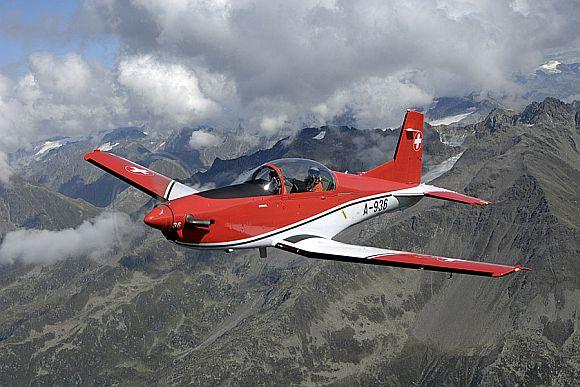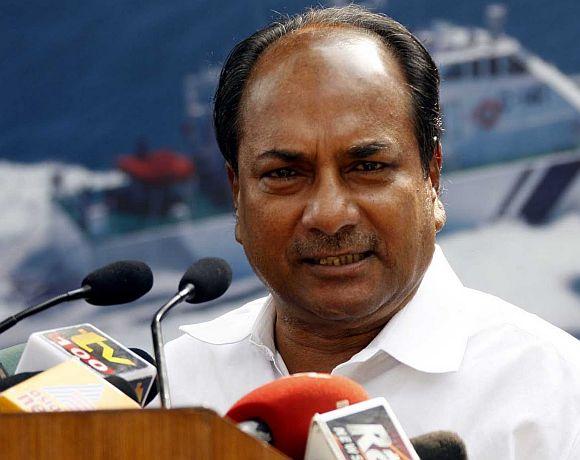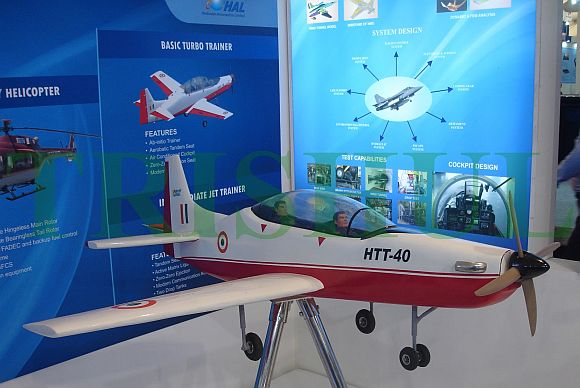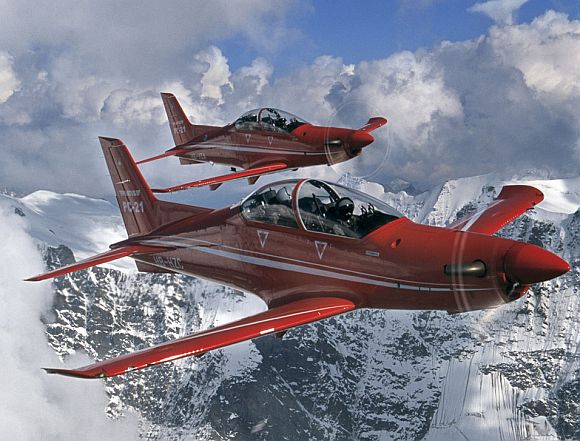A looming test case will soon make clear how serious the defence ministry is about its recently expressed intentions to end corruption in arms procurement by indigenising defence production.
Hindustan Aeronautics Limited, the Bengaluru-based public sector aircraft builder, has challenged the Indian Air Force's plan to purchase more Pilatus trainer aircraft by building a basic trainer aircraft, using its own funding.
Of the IAF's total requirement of 183 basic trainer aircraft, 75 PC-7 Mark II trainers have already been bought for Rs 2,900 crore from a Swiss company, Pilatus.
The first few trainers have already been delivered and the IAF will begin training rookie pilots on the PC-7 Mark II this July.
With the IAF's immediate requirement met, HAL demands the IAF buy 108 HTT-40 trainers to complete its fleet.
This has led to a dramatic three-way face-off between the MoD, HAL and the IAF.
...
The Rs 4,500 crore question for A K Antony
The IAF insists that it needs more Pilatus trainers immediately and is pressing the MoD to exercise the options clause in the Pilatus contract for 37 more PC-7 Mark II trainers.
HAL points out that Pilatus will complete delivery of the initial order for 75 trainers only in 2015. If the HTT-40 does not fly by then the options clause can be exercised then, bringing HAL's order down to 71 aircraft.
The MoD, which is the final arbiter, is caught in a cleft stick. Last year, the MoD chose the readily available Pilatus, saying the HTT-40 was more expensive.
But now, HAL has submitted a cheaper price bid. And with the MoD battered by allegations of corruption in foreign arms purchases, Defence Minister A K Antony is himself inclined to buy Indian.
Meanwhile a pro-active HAL has committed Rs 40 crore of company money to develop the HTT-40, and is allocating another Rs 160 crore that will also pay for three flying prototypes.
...
The Rs 4,500 crore question for A K Antony
At the Aero India 2013 show in Bengaluru in February, HAL exhibited a full-scale model of the HTT-40 and an impressive team of young aeronautical designers, who were calmly confident that the HTT-40, rather than the Pilatus PC-7 Mark II was the future of basic flying training in India's military.
Prashantsingh Bhadoria, one of the HTT-40's designers, told Business Standard the HTT-40 would eventually cost Rs 35 crore an aircraft, including the cost of developing a weaponised variant.
The 75 Pilatus that the IAF has already signed up for cost Rs 38.5 crore per aircraft. The HAL team at Aero India 2013 said that the HTT-40's only two imported systems would be the engine and the ejection seat, which together cost Rs 6 crore.
"It is easy to see what benefits India's aerospace industry. The Rs 38.5 crore that we pay for each Pilatus PC-7 Mark II goes entirely to Swiss manufacturers. Of the Rs 34.5 crore that each HTT-40 will cost, India's aerospace industry will get Rs 29 crore; only Rs 6 crore will go abroad," says Bhadoria.
A MoD rethink is underway. The ministry's high-level Defence Procurement Group has asked HAL to prepare a lifecycle costing of the HTT-40, an estimation of what the trainer will cost to buy, operate, maintain, upgrade and overhaul during its estimated service lifespan of 30-40 years.
Given that the HTT-40 will be built, maintained, overhauled and upgraded in HAL, the Pilatus will inevitably appear more expensive in a life cycle comparison.
...
The Rs 4,500 crore question for A K Antony
Top HAL sources tell Business Standard that the lifecycle estimates make a fleet of 108 HTT-40's trainers cheaper than a PC-7 Mark II fleet by Rs 4,500 crore.
MoD officials say the lifecycle comparisons will be evaluated by the DPG and then taken before the ministry's apex Defence Acquisition Council (DAC). If the DAC approves the project, HAL will get funding and IAF orders for up to 108 trainer aircraft.
HAL has also proposed supplying the HTT-40 to the Indian Navy, which will eventually have a little more than 500 aircraft, including aircraft carrier-based fighters. HAL is confident the navy will eventually set up its own training establishment, instead of training naval pilots in IAF training facilities. This would provide an additional market for the HTT-40.
HAL's projections suggest the HTT-40 will fly at 600 km an hour, reach an altitude of 10,000 metres, fly 3,000 km non-stop, and carry a 500-pound bomb or a mix of weaponry like guns, rockets and bombs. This would allow the HTT-40 to operate as a light strike aircraft, like the Hawker Beechcraft AT-6, which the US is considering for supply to the Afghan National Air Force.
The HTT-40 and the Pilatus PC-7 Mark II are 'Stage-1', trainers for rookie pilots, replace the obsolescent HPT-36. After basic training, fighter pilots will move on to 'Stage-2' training on the Intermediate Jet Trainer, which HAL is developing. After that, pilots will graduate to 'Stage-3' training on the Hawk advanced jet trainer. Only after that will they fly IAF frontline combat aircraft.






article